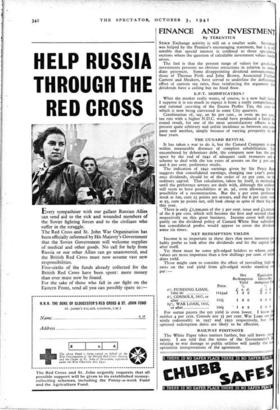FINANCE AND INVESTMENT
By TERENTIUS
STOCK Exchange activity is still on a smaller scale. Sentitnem was helped by the Premier's encouraging statement, but it is still notable that special interest is confined to those speculative sections where the question of calculable investment values hatch arises.
The fact is that the present range of values for good-dau investments presents no obvious attractions in relation to inune diate prospects. Some disappointing dividend announcements, those of Thomas Firth and John Brown, Associated Portland Cement and Meakers, have served to underline the deflationary effect of current tax rates, thus reinforcing the argument that dividends have a ceiling but no fixed floor.
E.P.T. MODIFICATION?
What the market really wants, of course, is a new bull factor, I suppose it is too much to expect it from a really comprehensive and rational recasting of the Excess Profits Tax, the case fat which is now being canvassed in some City quarters.
Combination of, say, an So per cent., or even 90 per cent, tax rate with a higher N.D.C. would have produced a fairer alb round result, for one of the most uniatisfac-tory effects is the present quite arbitrary and unfair incidence as between one cora pany and another, simply because of varying prosperity in tho base years.
THE CUNARD REVIVAL
It has taken a war to do it, but the Cunard Company is an within measurable distance of complete rehabilitation. Us encumbered by debenture debt, the company now has the pro, spect by the end of 1942 of adequate cash resources and scheme to deal with the ten years of arrears on the 5 per cent and 6 per cent. preference stocks.
The indication of 1942 earnings given by Sir Percy Bate, suggests that consolidated earnings, charging one 5 ear's prefer ence dividends, should be of the order of to per cent. on thi ordinary capital. That calculation, taken by itself, is mislead' until the preference arrears are dealt with, although the ordinar✓ still seem to have possibilities at 9s. 3d., even allowing for du possibility of a reconstruction. But the 5 per cent. preferenqq stock at too, cum 25 points net arrears, and the 6 per cent. stal at 93, cum 30 points net, still look cheap in spite of their big cis this year.
There is only L1,500,000 of the 5 per cent. issue and Li,000,co of the 6 per cent. which will become the first and second char respectively on this great business. Income cover will depea partly on the dividend policy of Cunard White Star subsidiarl but consolidated profits would appear to cover the dividend some six times.
NET REDEMPTION YIELDS
Income is so important in these days that most investors pro bably prefer to look after the dividends and let the capital lod after itself.
Yet there must be some gilt-edged holders to whom capita values are more important than a few shillings per cent. of inane diate yield.
These might care to consider the effect of prevailing high ti rates on the real yield from gilt-edged stocks standing nvtl par :—
Net Equivalent Redemption Gross-Re- Yield demption Yd Price. °/a 4% FUNDING LOAN, s. d. £ s. d. 1960-90 1144xd 1 2 6 2 5 0 4% CONSOLS, 1957, or after 112} 1 3 0 2 6 0 31% WAR LOAN, 1952, • or after 1061 1 4 3 2 8 6 For surtax payers the net yield is even lower. I know till neither 4 per cent. Consols nor 31 per cent. War Loan are del nitely redeemable in 1957 and 1952 respectively, but the optional redemption dates are likely to be effective.
RAILWAY FOOTNOTE
The White Paper takes matters further, but still leaves ume tainty. I am told that the terms of the Government's BI relating to war damage to public utilities will justify the u optimistic interpretations of the agreement.


























 Previous page
Previous page